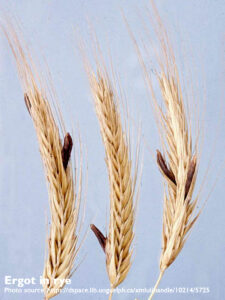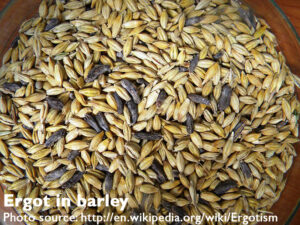Ergot Spotted in Western Canada -Keep an Eye Out
This is a guest post written by Karin Schmid, Beef Production Specialist with the Alberta Beef Producers.
The cool, wet conditions across parts of the country this spring, especially in Alberta and Saskatchewan, may have created the perfect environment for ergot. While virtually unheard of a decade or two ago, veterinarians and researchers agree that problems with ergot are clearly on the rise in the prairies.
What is ergot?
Ergot is a plant disease caused by the Claviceps purpurea fungus. Although traditionally associated with rye and triticale, ergot also affects wheat, barley, and a variety of grasses including bromegrass, quackgrass, wheatgrass, orchardgrass, wild rye, and bluegrasses.
The ergot bodies (sclerotia) are hard, vary in size, and are black or dark purple with a white to grey-coloured interior. Ergot bodies are formed in place of grain kernels, so ergot development is evident during heading, and more specifically during kernel formation.
Where does ergot come from?
Ergot bodies may be present in a field from a previous cereal crop, or from grasses bordering the field. They can also be introduced by planting contaminated seed. The fungus overwinters in the hard bodies and in the spring the fungus germinates and forms mushroom-like structures that produce spores. These spores invade flowering plants and replace the grain.
A longer flowering period results in a greater chance of infection. Because cool, wet weather can delay pollination and seed production, ergot is most commonly seen in years when those weather conditions have occurred. Copper deficiency in the soil may also increase the flowering period by causing pollen sterility.
Ergot bodies rarely survive for more than one year in the soil.
How costly are ergot infections?
While ergot does not cause significant yield losses in the crop, buyers will downgrade or reject loads of grain. In addition, ergot bodies contain a number of toxic alkaloids that are quite harmful to both humans and livestock. The alkaloids vary in toxicity and therefore ergot bodies can vary in toxicity depending on the amount and type of alkaloid they contain.
Is feeding ergot-infected crops to cattle a risk?
In cattle, ergot causes two main types of poisoning: convulsive/nervous and gangrenous. General symptoms of ergot poisoning (called ergotism) can take 2-8 weeks to appear.
The convulsive/nervous type of ergotism is rare in cattle. It is characterized by convulsions, muscle spasms, staggering, hyperexcitability, and even temporary paralysis. Usually these symptoms will disappear if the animal is removed from the contaminated feed.
In cattle, ergot causes two main types of poisoning: convulsive/nervous and gangrenous. General symptoms of ergot poisoning (called ergotism) can take 2-8 weeks to appear.
If you suspect ergot in a feed source, do not feed it until it has been tested or diluted appropriately.
If you suspect ergot poisoning (ergotism) in your herd, contact your veterinarian immediately and remove animals from the suspected contaminated feed as soon as possible.
The convulsive/nervous type of ergotism is rare in cattle. It is characterized by convulsions, muscle spasms, staggering, hyperexcitability, and even temporary paralysis. Usually these symptoms will disappear if the animal is removed from the contaminated feed.
The gangrenous type of ergotism is more common. Symptoms involve the animal’s extremities, like the nose, ears, tail, and legs. The ergot alkaloids cause constricted blood vessels, which severely impairs circulation. Early signs usually begin in the hind legs, and may include lameness, reluctance to move, and stamping of the feet. If the animal is removed from the contaminated feed at this stage, it may recover. However, continued consumption of ergot will result in a loss of sensation in the affected extremities, and an indentation will appear between the gangrenous tissue and the normal tissue. Eventually all tissue below that line will slough off. This process is accelerated in cold weather. Once tissue has begun to slough, the animal will not recover and should be euthanized.
Low levels of ergot in feed can also cause spontaneous abortion, and dramatically reduce milk production by suppressing prolactin, the main hormone responsible for controlling milk production. It is unclear if lactating animals are more susceptible, or if the effect is due to increased feed consumption during lactation.
Traditional guidelines stated that ergotism will occur when grain containing more than 0.1% ergot (1 ergot body/1000 grain kernels) is consumed. However, more recent research seems to indicate that that ergotism may occur at much lower levels than previously thought.
Young or pregnant cattle are especially susceptible to ergotism. Do not feed ergot contaminated feedstuffs to young or pregnant animals.
What do I do about ergot in my fields?
Ergot is difficult to control in crops because infection occurs long before the ergot bodies are visible. Once you have visual confirmation of ergot, you can’t do anything to stop the infection in the crop.
Can ergot be cleaned out of harvested grains?
Sometimes the ergot can be separated out of grain by size, but this presents problems if the ergot bodies are similar in size to the grain kernels or if they are broken. Gravity table cleaners work well because the ergot bodies are less dense than grain, but this process is expensive and rather slow. Colour sorting is a reliable method to ensure that the ergot is removed, but colour sorting technology is not available everywhere. Seed cleaning rates vary from $0.50-$0.95/bushel according to Alberta Agriculture and Rural Development survey data.
Grain screenings (the residue from the cleaning process) are often used to make pellets. Screenings can contain a higher proportion of ergot bodies, and processing them into pellets will make the ergot bodies impossible to detect. Special care should be taken to ensure that grain-screening pellets intended for feed do not contain ergot. The ethanol distillation process also has the potential to concentrate ergot alkaloids. While ethanol plants do have ergot limits, ensure that dried distiller’s grains (DDGS) made from wheat are ergot free.
Ergot has also been found in silage, and is very difficult to detect without testing because the ergot bodies are not readily apparent at the soft dough stage, when harvest occurs. The same would be true for crops intended for swathgrazing.
How do I know if my feed is safe?
Prairie Diagnostic Services (PDS) in Saskatoon has been accepting samples of grain and silage to test for ergot and other mycotoxins since Sept. 1, 2013. Previously, only a couple of places in the United States were able to test for ergot alkaloids. As the ergot alkaloid levels can be very high in contaminated seed heads but low or zero in unaffected plants, representative sampling methods are critical.
The best way to sample feed for ergot testing is an accumulation of many small samples taken from at least five locations in the bulk lot. The sampling probe should be long enough to reach the bottom of the container. It is recommended that each portion be about 200g and one portion be taken for every 200kg of product. If this aggregate sample is too large, it should be blended so that a representative subsample of an appropriate size (~1 kg) can be tested. Dynamic lots such as conveyor belts should involve multiple samples across the entire cross section of the moving stream.
Because there are indications that ergotism can occur at much lower concentrations than previously thought, PDS has a threshold of 100-200 parts per billion. Testing for ergot costs about $60, and results are currently returned the next day, although turnaround time for results is expected to increase slightly as the volume of samples they receive increases. If you’re interested in submitting a sample for testing, PDS can be contacted at 306-966-7316, or online at www.pdsinc.ca.
A few final considerations
Animals on pasture are generally safe from ergot poisoning, as they graze the plants before they reach the heading out stage. However, if you are planning to graze pasture with grasses that are already headed out, checking for ergot is a good idea.
Feed contaminated with ergot may be diluted with clean feed until the ergot concentration is reduced to a safe level. Because there is some uncertainty as to what that safe level is, it is a good idea to dilute past the previous standard of 0.1%. For feed with heavy contamination, it is likely more economical to buy new feed.
Crop rotation away from cereals to broadleaf crops for one or two years can reduce ergot infections in crops, as ergot bodies only survive in the soil for one year, and broadleaf plants are not susceptible. Mowing or grazing neighboring headlands and roadways before they flower can prevent bordering grasslands from becoming hosts to ergot infections, which can then spread to crops.
If you suspect ergot in a feed source, do not feed it until it has been tested or diluted appropriately.
If you suspect ergotism, contact your veterinarian immediately, and remove animals from the suspected contaminated feed as soon as possible.
The author wishes to thank Drs. Barry Blakley, John McKinnon, and Eugene Janzen for their assistance while researching this article, and Dr. Barry Blakley for reviewing the content for accuracy.
Learn more
Ergot (University of Saskatchewan Agriculture)
Ergot: Low levels case big problems (BCRC Blog post)
From Field to Feed: Understanding Ergot (RealAgriculture.com)
Frozen ears and feet — but not from the cold (Manitoba Co-Operator)
Click here to subscribe to the BCRC Blog and receive email notifications when new content is posted.
The sharing or reprinting of BCRC Blog articles is welcome and encouraged. Please provide acknowledgement to the Beef Cattle Research Council, list the website address, www.BeefResearch.ca, and let us know you chose to share the article by emailing us at [email protected].
We welcome your questions, comments and suggestions. Contact us directly at [email protected] or generate public discussion by posting your thoughts below.

